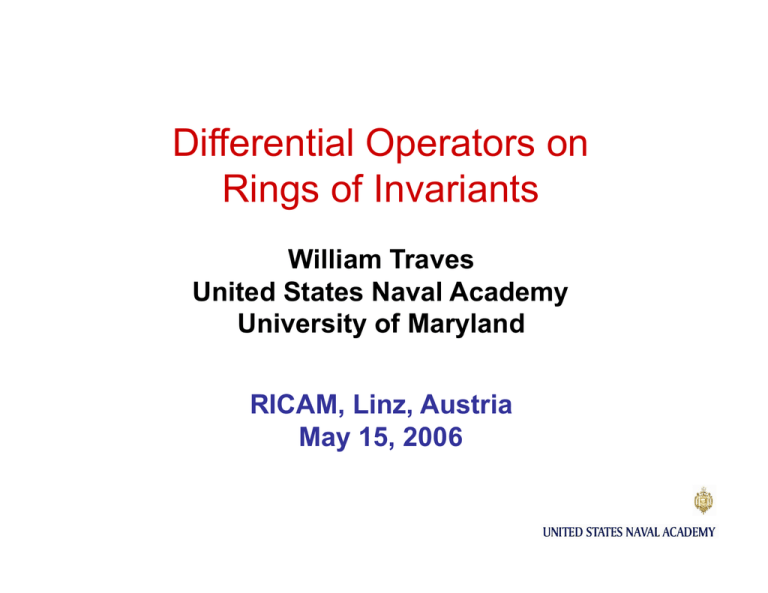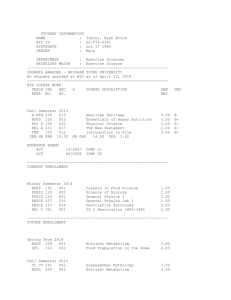Differential Operators on Rings of Invariants William Traves United States Naval Academy
advertisement

Differential Operators on
Rings of Invariants
William Traves
United States Naval Academy
University of Maryland
RICAM, Linz, Austria
May 15, 2006
Outline
(1) Rings of invariants
(a) geometric meaning and examples
(b) structural properties
(c) computational results: Derksen’s algorithm
(2) Differential operators on rings of invariants
(a) invariant operators
(b) D(RG) ≠ D(R)G
(c) computing using Gröbner bases and
ideas from commutative algebra
Quotient Varieties
Suppose a group G acts on a variety X.
Question: Do the orbits of G form a variety?
That is, can we make X/G into a variety?
Answer: Sometimes. When G is finite then X/G is a
variety, but if G is not finite we may need to exclude
certain orbits to make the set of orbits into a variety.
Example
(x,y)
(0,0)
(-x,-y)
G = Z2 acting on X = C2
(x, y) (-x, -y).
The orbit space X/G
is a variety.
R = C[x,y] and G acts on R
(g•r)(x,y) = r(g-1•(x,y)).
C[X/G] = RG = {r∈R : g•r = r
for all g∈G}
= C[x2, xy, y2]
X//G = Spec(RG) is the
categorical quotient.
Example
RG = C so X//G = pt.
So X//G ≠ X/G.
But X-{(0,0)}/G is a
projective variety.
G = C* acting on X = C2
t(x,y) (tx, ty)
The orbit {(0,0)} is in the closure of
all other orbits.
Now X/G is not a variety.
In general P(semistable pts)
is a projective variety that
maps to P(RG).
Summary of Examples
The categorical quotient X//G has coordinate ring
RG and in good cases it represents the orbits of
semistable points in X.
This construction leads to many interesting
quotient spaces:
• orbifolds – G = finite group
• projective space – G = C*
• Grassmanians G(k,n) – G = SLnC
• moduli spaces of points (e.g. Hilbert schemes)
Properties of RG
It is generally difficult to compute RG explicitly.
Gordan (1868) showed that C[X]SL2C is finitely
generated. In 1890 Hilbert showed that RG is
finitely generated when G is linearly reductive.
Nagata showed that this can fail when G is not l.r.
P. Gordan
D. Hilbert
M. Nagata
Properties of RG
It is generally difficult to compute RG explicitly.
Gordan (1868) showed that C[X]SL2C is finitely
G is
generated. In 1890 Hilbert showed
that
R
Just use the Reynolds
finitely generated when G is linearly reductive.
operator!
Nagata showed that this can fail when G is not l.r.
P. Gordan
D. Hilbert
M. Nagata
The Reynolds operator
An algebraic group G is linearly reductive if for
every G-invariant subspace W of a G-vector space
V, the complement of W is G-invariant too:
V = W ⊕ WC.
The Reynolds operator
An algebraic group G is linearly reductive if for
every G-invariant subspace W of a G-vector space
V, the complement of W is G-invariant too:
V = W ⊕ WC.
RG R is a graded map and for each degree
we can decompose Rd = (RG)d ⊕ Td.
As a result, we can split the inclusion by
projecting onto the RG factors.
The Reynolds operator cont.
When G is a finite group, the Reynolds operator
is just an averaging operator
If G is infinite, then can define the Reynolds
operator by integrating over a compact subgroup.
There are also explicit algebraic algorithms to
compute the Reynolds operator in the case of
SL2C (see Derksen and Kemper’s book).
Hilbert’s wonderful proof
Thm (Hilbert): If G is lin. reductive then RG is f.g.
Proof:
The Hochster-Roberts theorem
Thm (Hochster and Roberts): If G is linearly
reductive, then RG is Cohen-Macaulay.
An elegant proof of the result uses reduction
to prime characteristic and
the theory of tight closure.
Mel Hochster
Computing invariants
Several methods:
(1) Gordan’s symbolic calculus (P. Olver)
(2) Cayley’s omega process
(3) Lie algebra methods (Sturmfels)
(4) Derksen’s algorithm (Derksen and Kemper)
Harm Derksen and
Gregor Kemper.
Derksen’s Algorithm
(1) Hilbert ideal I = ideal of R gen by RG>0
(2) To find I, we first look at the map
Gröbner
bases!
Compute the ideal β by elimination and set
y’s to 0 to get gens for the Hilbert ideal IR.
(3) The gens of I may not be invariants but
we can apply the Reynolds operator to get
invariants that generate I and RG.
Easy example
Let R=C[x,y,z] and G=Z2.
Let G act on R by σ(x) = -x, σ(y)=z, σ(z) = y.
We represent G as V(t2-1) and the action
by the interpolation matrix
Easy example continued
t•x = tx
t•y = (t+1)y/2 + (1-t)z/2
t•z = (1-t)y/2 + (1+t)z/2
The ideal defining the graph of
is
β = (t2 – 1, y1 - t•x, y2 - t•y, y3 - t•z) ⊂ C[t,x,y,z,y1, y2, y3]
We compute the elimination ideal β ∩ C[x,y,z, y1, y2, y3]
and set y1 = y2 = y3 = 0 to get (y+z, z2, xz, x2).
Applying the Reynolds operator R(f)=[f(x,y,z)+f(-x,z,y)]/2
gives gens for RG: y+z, y2+z2, xz-xy, and x2.
Group actions on the Weyl algebra
Idea: replace R=C[x] with D(R)=C<x,∂x> and compute
D(R)G = C<x,∂x>G.
Extending the group action: G acts on an operator
θ∈D(R) by
(g•θ)(f) = g • (θ(g-1 • f)).
Concretely, if g acts on x1,…,xn by the matrix A then
g acts on ∂1,…, ∂n by the matrix (AT)-1.
This action preserves the defining relations on the
Weyl algebra:
The associated graded ring GrD(R)
D(R) is filtered: F0 ⊂ F1 ⊂ … ⊂ D(R) Fi = ops of
order ≤ i
GrD(R) = Fi / Fi-1 and σ: D(R) GrD(R)
θ∈Fi θ mod Fi-1
Write ξi for σ(∂i), so that GrD(R) = C[x1,…,xn,ξ1,…, ξn]
G acts on ξi just as on ∂i.
The associated graded ring GrD(R)
D(R) is filtered: F0 ⊂ F1 ⊂ … ⊂ D(R) Fi = ops of
order ≤ i
GrD(R) = Fi / Fi-1 and σ: D(R) GrD(R)
θ∈Fi θ mod Fi-1
Will Traves
Nobuki
Takayama
Derksen’s algorithm applied to the Weyl algebra
Lemma: [GrD(R)]G = Gr[D(R)G].
So we can apply Derksen’s algorithm to compute
generators for [GrD(R)]G = Gr[D(R)G].
Thm: If a set of elements generate Gr(S) then any
lifts of these elements generate S.
So lifting the generators of Gr[D(R)G] to D(R)G gives
generators of D(R)G.
Example
R = C[x,y,z], G = Z2=V(t2-1), t•x=-x, t•y=z, t•z=y.
RG = C[y+z, y2 + z2, xz-xy, x2].
G acts on GrD(R): t•ξ1= -ξ1, t•ξ2=ξ3, t•ξ3=ξ2.
β = (t2-1, y1-t•x, y2-t•y, y3-t•z, y4-t•ξ1 ,y5-t• ξ2, y6-t• ξ6)
Eliminate and set yi’s to zero:
(y+z,x2,xz,z2, ξ2+ξ3,ξ12,ξ1ξ3,ξ32,
zξ3,xξ3,zξ1,xξ1).
Apply Reynolds op: R(θ)=[θ+ θ(-x,z,y,-ξ1,ξ3,ξ2)]/2:
y+z,
x 2,
y2+z2,
xz-xy,
Lifts generate
ξ2+ξ3,
ξ12,
ξ22+ξ32, ξ1ξ3- ξ1ξ2, D(R)G
yξ2+zξ3, xξ3-xξ2, zξ1-yξ1, xξ1.
Example
R = C[x,y,z], G = Z2=V(t2-1), t•x=-x, t•y=z, t•z=y.
RG = C[y+z, y2 + z2, xz-xy, x2].
G acts on GrD(R): t•ξ1= -ξ1, t•ξ2=ξ3, t•ξ3=ξ2.
β = (t2-1, y1-t•x, y2-t•y, y3-t•z, y4-t•ξ1 ,y5-t• ξ2, y6-t• ξ6)
Eliminate and set yi’s to zero:
(y+z,x2,xz,z2, ξ2+ξ3,ξ12,ξ1ξ3,ξ32,
zξ3,xξ3,zξ1,xξ1).
Apply Reynolds op: R(θ)=[θ+ θ(-x,z,y,-ξ1,ξ3,ξ2)]/2:
y+z,
x 2,
y2+z2,
xz-xy,
Robertz &
ξ2+ξ3,
ξ12,
ξ22+ξ32, ξ1ξ3- ξ1ξ2,
Plesken
yξ2+zξ3, xξ3-xξ2, zξ1-yξ1, xξ1.
Computing Relations in GrD(R)G and D(R)G
We can compute relations among the generators
in GrD(R)G by elimination and then lift to relations
in D(R)G.
Thm (_): The lifted relations, together with the
commutator relations among the generators,
generate the two-sided ideal of relations in D(R)G.
In our example, there are 33 nontrivial commutator
relations and 40 lifted relations among the generators.
These relations are invariant under the Fourier transform
xi
∂i because A∈O(3) so (AT)-1=A.
The ring D(RG)
Grothendieck defined a ring of differential operators
Dk(S) for each k-algebra S. However, DC(RG)≠D(R)G.
If RG = C[t1,…,tm]/J then
The two rings are related: π: X X//G induces the
inclusion RG R and this induces a map
π*: D(R)G D(RG).
Thm (Kantor, Levasseur): When G is a finite group,
π* is injective.
When π* fails to be surjective
Example: G=Z2 acts on R=C[x] by x -x. RG=C[x2]
so D(RG) is a Weyl algebra, but D(R)G = C<x2, x∂, ∂2>
so π* is not surjective.
The group G is generated by pseudoreflections
(g∈G a pseudoref iff ρ(g) has eigenvalues 1,1, …,1,η.)
Thm (Sheppard-Todd-Chevalley): RG is a poly ring and
D(RG) is a Weyl algebra if and only if G is generated by
pseudoreflections.
No pseudoreflections π* surjective
Thm (Kantor, Levasseur): When G is a finite group
the map π* is surjective precisely when G contains
no pseudoreflections. In such cases, D(R)G = D(RG).
In our running example, G contains no pseudorefs and
so D(RG) = D(R)G.
When G contains some pseudoreflections, they
generate a normal subgroup P G. Then
RG = (RP)G/P and D(RG) = π*(D(RP)G/P),
where now RP is a poly ring, D(RP) is a Weyl algebra,
and the map π* comes from the inclusion RG ⊂ RP.
Example
Grassmanians
Each subspace represented by a choice of basis:
SLnC acts on Cn in a natural way and acts on a
the matrix M by change of basis: g•Mx = M[g•x].
semistable points = full rank matrices
and the quotient identifies those whose columns
generate the same subspace of Cn.
Fundamental Theorem of Invariant Theory:
The ring RG is generated by the determinants of the
2x2 minors of our matrix, [jk] = xj1xk2 – xk1xj2, subject
to the Plücker relation: [12][34] – [13][24] + [14][23] = 0
The ring GrD(R)G
The FTIT applies more generally, to
This turns out to be precisely GrD(R)G. We have:
6 Plücker coordinates,
6 similar coordinates in the ξi’s and
16 mixed coordinates involving both xi’s and ξj’s.
As well, Popov and Vinberg described the relations
among these invariants.
[jk] = xj1xk2 – xk1xj2 = det of jth and kth columns
The ring GrD(R)G
The FTIT applies more generally, to
This turns out to be precisely GrD(R)G. We have:
6 Plücker coordinates,
6 similar coordinates in the ξi’s and
16 mixed coordinates involving both xi’s and ξj’s.
As well, Popov and Vinberg described the relations
among these invariants.
|j k| = ξj1 ξk2 – ξk1 ξ j2 = det of jth and kth columns
The ring GrD(R)G
The FTIT applies more generally, to
This turns out to be precisely GrD(R)G. We have:
6 Plücker coordinates,
6 similar coordinates in the ξi’s and
16 mixed coordinates involving both xi’s and ξj’s.
As well, Popov and Vinberg described the relations
among these invariants.
<j k> = xj1 ξk2 + xj1 ξk2 = dot product of jth and kth cols
The ring GrD(R)G
The FTIT applies more generally, to
This turns out to be precisely GrD(R)G. We have:
6 Plücker coordinates,
6 similar coordinates in the ξi’s and
16 mixed coordinates involving both xi’s and ξj’s.
As well, Popov and Vinberg described the relations
among these invariants.
Lifting these generators gives generators for D(R)G.
Thm(_): The relations can also be lifted to D(R)G.
What about the ring D(RG)?
The ring D(RG)
What about the ring D(RG)? Need to use the map π*.
Schwarz showed that π* is surjective in this
case and has kernel generated by D(R)g ∩D(R)G.
Thm(_): The kernel of this map is a principal 2-sided
ideal and is generated by the Casimir
operator, an operator generating the center of g.
C = θ(θ+2) – 4 Σ [jk] |jk| where
θ = <11> + <22> + <33> + <44>
Gerry Schwarz
Thank you.
Danke schön.





